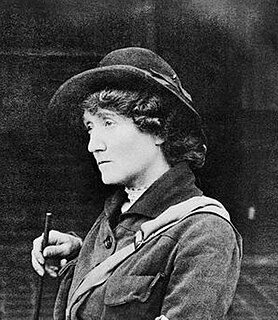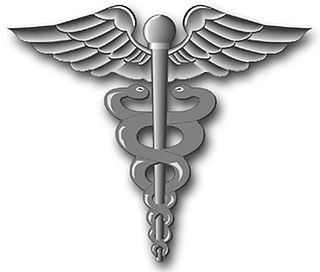
Yeomanry is a designation used by a number of units or sub-units of the British Army Reserve, descended from volunteer cavalry regiments. Today, Yeomanry units serve in a variety of different military roles.

The First Aid Nursing Yeomanry is a British independent all-female registered charity formed in 1907 and active in both nursing and intelligence work during the World Wars. Its members wear a military-style uniform, but it is not part of the Regular Army or Army Reserve; members do not train at Sandhurst, nor do they hold a commission.

The United States Navy Nurse Corps was officially established by Congress in 1908; however, unofficially, women had been working as nurses aboard Navy ships and in Navy hospitals for nearly 100 years. The Corps was all-female until 1965.

Sara Talbot MM, also known as Sadie Talbot, was a British ambulance and supply driver in the First World War. She was awarded the Military Medal for her work in France with the Canadian Army Service Corps and later joined the First Aid Nursing Yeomanry. She died at the age of 105.

Women in World War I were mobilized in unprecedented numbers on all sides. The vast majority of these women were drafted into the civilian work force to replace conscripted men or work in greatly expanded munitions factories. Thousands served in the military in support roles, e.g. as nurses, but in Turkey some saw combat as well.

Flora Sandes was a British woman who served as a member of the Royal Serbian Army in World War I. She was the only British woman officially to serve as a soldier in that war. Initially a St. John Ambulance volunteer, she travelled to the Kingdom of Serbia, where she was welcomed and formally enrolled in the Serbian army. She was subsequently promoted to the rank of Sergeant major, and, after the war, to Captain. She was decorated with seven medals.
The word "nurse" originally came from the Latin word "nutrire", meaning to suckle, referring to a wet-nurse; only in the late 16th century did it attain its modern meaning of a person who cares for the infirm.

The state of medical knowledge at the time of the Civil War was extremely primitive. Doctors did not understand infection, and did little to prevent it. It was a time before antiseptics, and a time when there was no attempt to maintain sterility during surgery. No antibiotics were available, and minor wounds could easily become infected, and hence fatal. While the typical soldier was at risk of being hit by rifle or artillery fire, he faced an even greater risk of dying from disease.

The United States Army Nurse Corps was formally established by the U.S. Congress in 1901. It is one of the six medical special branches of officers which – along with medical enlisted soldiers – comprise the Army Medical Department (AMEDD).
The history of medicine in the United States encompasses a variety of periods and approaches to health care in the United States from colonial days to the present, ranging from early folk remedies to the increasing professionalization and managed care of modern medicine.
The history of nursing in the United Kingdom relates to the development of the profession since the 1850s. The history of nursing itself dates back to ancient history, when the sick were cared for in temples and places of worship. In the early Christian era, nursing in the United Kingdom was undertaken by certain women in the Christian Church, their services being extended to patients in their homes. These women had no real training by today's standards, but experience taught them valuable skills, especially in the use of herbs and folk drugs, and some gained fame as the physicians of their era. Remnants of the religious nature of nurses remains in Britain today, especially with the retention of the job title "Sister" for a senior female nurse.

The history of nursing in the United States focuses on the professionalization of nursing since the Civil War.

American Red Cross Motor Corps was founded in 1917 by the American Red Cross (ARC). The service was composed of women and it was developed to render supplementary aid to the US Army and Navy in transporting troops and supplies during World War I, and to assist other ARC workers in conducting their various relief activities. The diverse character of the work included canteen work, military hospitals, camps and cantonments, home service workers, outside aid, office detail, other ARC activities, and miscellaneous services, such as the 1918 flu pandemic.
The 1919 Birthday Honours were appointments by King George V to various orders and honours to reward and highlight good works by citizens of the British Empire. The appointments were made to celebrate the official birthday of The King, and were published in The London Gazette from 3 June to 12 August. The vast majority of the awards were related to the recently ended War, and were divided by military campaigns. A supplementary list of honours, retroactive to the King's birthday, was released in December 1919.

Mabel Annie St Clair Stobart was a British suffragist and aid-worker. She created and commanded all-women medical units to serve in the Balkan Wars and the First World War. She became the first woman to achieve the rank of Major in any national army. She was also the author of several books and articles.

Alice Hutchison was a British doctor who served in the Balkan and First World Wars. She was one of the first women to lead a war-time hospital unit.

Grace McDougall or Grace Alexandra Smith or Grace Ashley-Smith was a British officer of the First Aid Nursing Yeomanry (FANY). She is credited with reinventing that organisation and with being the first khaki bride. She gained British, French and Belgian medals.

United States Army Hospital Corps was organized in 1886 in order to recruit and retain competent medical enlisted personnel in the United States Army Medical Department for field service in the event of a foreign war. Existing Hospital Stewards were not trained to perform duties as field medical personnel. The Corps was recruited from enlisted men who had served one year in the line. After training they were transferred to a post where they would be assigned duties as nurse, cook or medical attendant. Privates having served twelve months in the Corps could be recommended for promotion. Having passed an examination they were promoted to Acting Hospital Stewards (Sergeant). Promotion to full Hospital Steward was possible after one year's service in an acting capacity and after having passed a second and more rigorous examination. The peak strength of the Corps was reached in November 1898, during the Spanish–American War, with about 6,000 men serving in the Corps.

Lilian Annie Margueretta Franklin OBE, known as "Boss", was the British commanding officer of the First Aid Nursing Yeomanry (FANY) until 1932. She took the organisation of six volunteers to organise hospitals and nursing stations in France and Belgium in the First World War. In 1916 the British Army agreed that it too could use the FANY's support and Franklin was the first driver and in command. She left the FANY in 1932.

Mary Eva Hastings Morris was a Welsh doctor and suffragist. Born in Dolgellau, she grew up in Malta, before returning to Wales to study medicine at the University College of Wales in Aberystwyth. She went on to become the first female doctor from Aberystwyth. After spells working at Great Ormond Street Children's Hospital in London, the North Devon Infirmary, and Bristol Royal Hospital for Sick Children and Women, Morris moved to Bath, where she worked as a medical inspector.

















